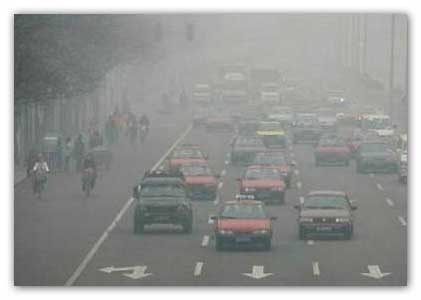|
Scientists examined relationship between air
pollution and both HDL cholesterol and HDL particle
number in the MESA Air study (Multi-Ethnic Study of
Atherosclerosis Air Pollution).

High-density lipoprotein (HDL) cholesterol helps
curb the odds of heart disease by purging blood
vessels of debris and lowering levels of
triglycerides, dangerous fats that can make blood
thicker, stickier and more prone to clots.
Researchers studied 6,654 adults and found people
exposed to higher levels of fine, ultrafine
particles (PM2.5) and black carbon concentrations in
traffic pollution tended to have lower levels of HDL
cholesterol in their blood.
Exposure periods were averaged to 12 months, 3
months, and 2 weeks prior to examination.
HDL cholesterol and HDL particle number were
measured in the year 2000 using the cholesterol
oxidase method and nuclear magnetic resonance
spectroscopy, respectively.
Researchers used multivariable linear regression to
examine the relationship between air pollution
exposure and HDL measures.
Study participants were 62 years old on average, and
half of them were current or former smokers.
About 16 percent of the participants took
cholesterol-lowering drugs and roughly 45 percent
had high blood pressure.
None had cardiovascular disease at the start of the
study period.
Researchers used participants’ home addresses to
estimate average exposure to PM 2.5 and black carbon
over 12-month, three-month and two-week periods in
the year 2000.
They also looked at blood levels of HDL cholesterol
and another measure known as HDL particle count,
which some scientists believe may be a more accurate
way to assess heart disease risk.
Over one year, people exposed to more black carbon
had lower levels of HDL cholesterol than
participants with little or no exposure to black
carbon. The difference was small, but statistically
meaningful.
Higher black carbon exposure over one year was also
associated with lower HDL particle counts, but this
difference was too small to rule out the possibility
that it was due to chance, researchers report in the
journal Arteriosclerosis, Thrombosis, and Vascular
Biology.
Over three months, however, the picture looked
different.
In this shorter-term analysis, higher levels of fine
particulate matter were associated with a lower HDL
particle count.
The slightly lower level of HDL cholesterol seen
with high pollution exposure was too small a
difference to rule out chance, but it was still
comparable to the rise in HDL seen when smokers
quit, the researchers note.
The study wasn’t a controlled experiment designed to
prove how traffic fumes directly influence
cholesterol or the risk of heart disease.
These data are consistent with the hypothesis that
exposure to air pollution is adversely associated
with measures of HDL.
For more information
Arteriosclerosis, Thrombosis, and Vascular Biology
Association of Air Pollution Exposures With
High-Density Lipoprotein Cholesterol and Particle
Number
Link...
MDN |